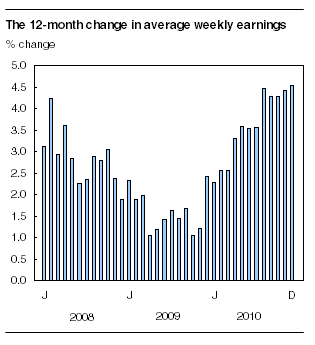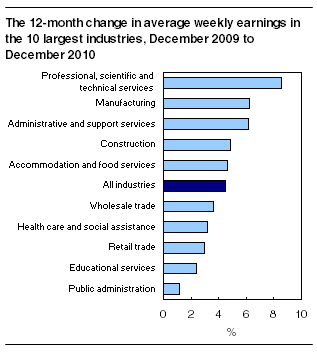Payroll employment, earnings and hours
Archived Content
Information identified as archived is provided for reference, research or recordkeeping purposes. It is not subject to the Government of Canada Web Standards and has not been altered or updated since it was archived. Please "contact us" to request a format other than those available.
Related subjects
-
[an error occurred while processing this directive]
Between December 2009 and December 2010, average weekly earnings of non-farm payroll employees rose 4.5% to $872.12. December marked the fifth consecutive month during which year-over-year growth was above 4.0%. In comparison, average weekly earnings grew by 2.4% from December 2008 to December 2009.

Note to readers
Every March 31, as part of the regularly scheduled year-end review of the Survey of Employment, Payrolls and Hours (SEPH), seasonally adjusted data are revised using the latest seasonal factors. On March 31, a new seasonal adjustment model (X-12-ARIMA) will also be introduced.
In addition, as part of the annual review, there will be revisions to a small number of industries for the 2006 to 2010 period.
As a result, all seasonally adjusted estimates will be revised historically back to 2001 and will be available on CANSIM (Tables 281-0025, 281-0028, 281-0031, and 281-0034). To facilitate access to the revised data, these CANSIM tables will be free from March 31 to April 6, 2011.
The SEPH is a business census of non-farm payroll employees. Statistics Canada also produces employment estimates from its monthly Labour Force Survey (LFS). As a result of conceptual and methodological differences, estimates of changes from SEPH and LFS do differ from time to time. However, the trends in the data are quite similar.
Unless otherwise stated, this release presents seasonally adjusted data, which facilitates comparisons by removing the effects of seasonal variations.
All earnings data include overtime pay and exclude businesses which could not be classified to a North American Industrial Classification System code.
Average weekly earnings are derived by dividing total weekly earnings by the number of employees.
Changes in average earnings can be influenced by a number of factors. Changes in the level of earnings, the number of payroll employees, and the number of hours worked can have an impact. Other factors could include compositional changes over time, such as changes in the proportions of full-time and part-time work; proportions of casual, senior and junior employees; the occupational distribution within and across industries; and in the distribution of employment between industries. Such effects may apply differently within different provinces and territories, and over time.
Some of the growth in weekly earnings between December 2009 and December 2010 was attributable to a 1.8% increase in the average workweek to 33.0 hours. This followed a 0.5% decline in average hours from December 2008 to December 2009. The remainder of the year-over-year wage increase in December reflects a number of other factors, including wage growth, changes in the composition of employment by industry, changes in occupations within industries and job experience.
Average weekly earnings increased in every province. Growth was above the national average in Prince Edward Island, Nova Scotia, Alberta, Newfoundland and Labrador, and Quebec. New Brunswick and British Columbia had the slowest growth.
Average weekly earnings by industry
Among the 10 largest industries, growth in average weekly earnings between December 2009 and December 2010 was above the national average of 4.5% in professional, scientific and technical services; manufacturing; administrative and support services; construction; as well as accommodation and food services. The slowest growth in earnings occurred in public administration.

Average weekly earnings in professional, scientific and technical services increased by 8.5% in the 12 months to December. Most of this gain was driven by a notable increase between November and December associated with larger than usual year-end payments such as bonuses and annual payments. Year-over-year growth in earnings was strong in eight of the nine industries in this sector.
Manufacturing earnings increased by 6.2% in the 12 months to December. Growth was particularly strong in a number of manufacturing industries, including petroleum and coal products; paper; furniture and related products; machinery; electrical equipment, appliance and components; and primary metals.
Average weekly earnings rose by 6.1% in administrative and support services in the 12 months to December. Earnings in this industry have been increasing since May 2009.
Earnings in construction have also been on an upward trend. From December 2009 to December 2010, earnings rose by 4.9%, with particularly strong growth in heavy and civil engineering construction and specialty trade contractors.
Earnings in accommodation and food services were up 4.7%, with most of the growth in traveller accommodation; full-service restaurants; and drinking places.
Growth in average weekly earnings was also strong in some smaller industries. Earnings in arts, entertainment and recreation have been on an upward trend. From December 2009 to December 2010, earnings in this industry rose by 10.9%, the fastest among all industries. Growth was particularly strong for spectator sports as well as independent artists, writers and performers.
In forestry, logging and support activities, average weekly earnings increased by 8.6%, driven fully by earnings growth in the logging industry.
Non-farm payroll employment by industry
Non-farm payroll employment increased by 0.3% (+40,900) from November to December, the seventh consecutive month of job gains. Between December 2009 and December 2010, the number of payroll employees increased by 2.0% (+297,600).
Payroll employment rose in both the goods and services sectors in December compared with November.
In manufacturing, payroll employment increased by 6,500 (+0.4%) from November to December. Payroll jobs in this industry increased steadily in the 12 months to December, up 1.9% (+27,900). Most of the gains during 2010 were in machinery; primary metal; food; fabricated metal product; plastics and rubber products; and petroleum and coal product manufacturing.
Payroll jobs in retail trade increased by 6,200 (+0.3%) in December, the third consecutive month of gains. These gains made up for losses earlier in 2010, and left employment unchanged in December compared with December 2009.
The number of payroll jobs in administrative and support services rose by 5,800 (+0.8%) in December, bringing total gains in 2010 to 18,000 (+2.5%). The increases over the year were primarily in employment services and services to buildings and dwellings.
There were also gains in educational services; transportation and warehousing; professional, scientific and technical services; mining, quarrying and oil and gas extraction and health care and social assistance in December.
From December 2009 to December 2010, the three industries with the fastest rates of job growth were mining, quarrying and oil and gas extraction (+13.2%), construction (+3.2%) and professional, scientific and technical services (+2.6%).
Hours worked and average hours worked by hourly and salaried employees
Total hours worked by hourly and salaried employees increased by 0.3% in December compared with November. In the 12 months to December, total hours advanced by 3.4%.
Average weekly hours worked by hourly and salaried employees amounted to 33.0 hours in December, unchanged from November and up 1.8% from December 2009.
Available on CANSIM: tables 281-0023 to 281-0039 and 281-0041 to 281-0046.
Definitions, data sources and methods: survey number 2612.
Detailed industry data, data by size of enterprise based on employment, and other labour market indicators will be available soon in the monthly publication Employment, Earnings and Hours (72-002-X, free).
Data on payroll employment, earnings and hours for January will be released on March 31.
For more information, or to order data, contact Client Services (toll-free 1-866-873-8788; 613-951-4090; labour@statcan.gc.ca). To enquire about revisions, concepts, methods or data quality of this release, contact Jeannine Usalcas (613-951-4720), Labour Statistics Division.
- Date modified:
